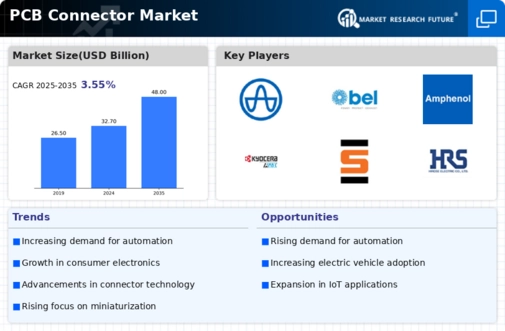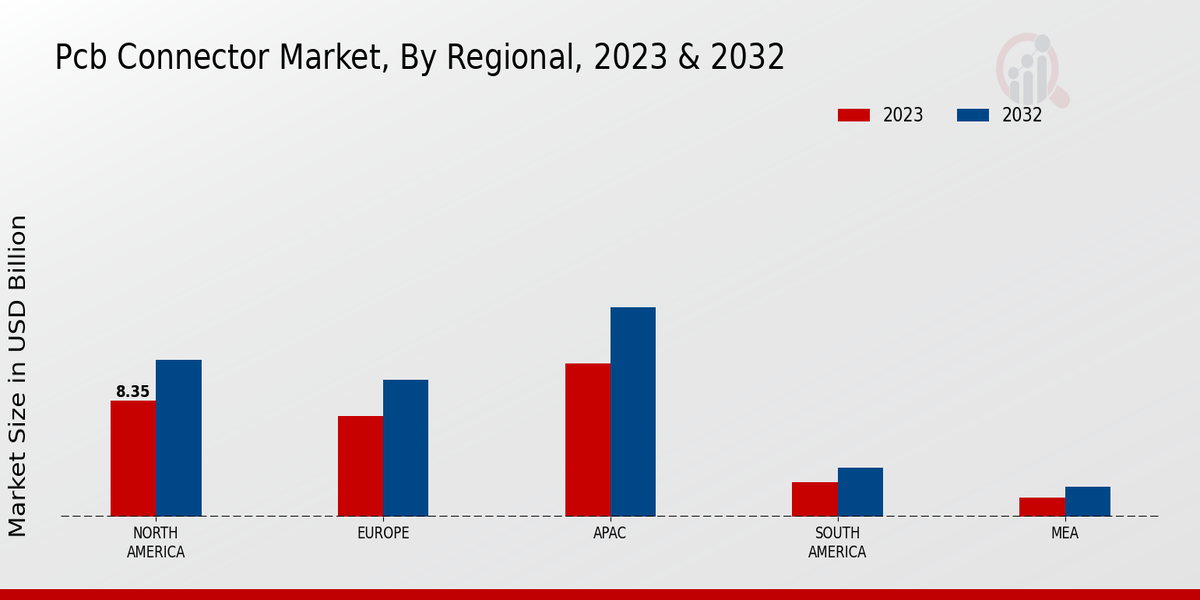Emergence of IoT Devices
The Global PCB Connector Market Industry is significantly impacted by the emergence of Internet of Things (IoT) devices. As more devices become interconnected, the demand for efficient and compact PCB connectors rises. IoT applications span various sectors, including healthcare, agriculture, and smart cities, necessitating connectors that can support diverse functionalities. The growth of IoT is expected to drive the PCB connector market, with the industry projected to reach 48.0 USD Billion by 2035. This expansion indicates a growing need for connectors that can facilitate seamless communication between devices, thereby enhancing the overall functionality of IoT systems. The trend suggests a promising future for PCB connectors in the IoT landscape.
Market Growth Projections
The Global PCB Connector Market Industry is projected to experience substantial growth in the coming years, with estimates indicating a market size of 32.7 USD Billion in 2024 and a potential increase to 48.0 USD Billion by 2035. This growth trajectory suggests a compound annual growth rate (CAGR) of 3.55% from 2025 to 2035. Such projections reflect the increasing demand for PCB connectors across various applications, including consumer electronics, automotive, and industrial automation. The anticipated growth underscores the importance of innovation and adaptation within the industry to meet evolving market needs and technological advancements.
Growth in Industrial Automation
The Global PCB Connector Market Industry is poised for growth due to the increasing adoption of industrial automation across various sectors. Industries are increasingly utilizing automated systems to enhance efficiency and productivity, which in turn drives the demand for reliable PCB connectors. As factories and manufacturing facilities modernize, the need for connectors that can withstand harsh environments and provide stable connections becomes critical. This trend is expected to contribute to the market's expansion, with projections indicating a compound annual growth rate (CAGR) of 3.55% from 2025 to 2035. The integration of smart technologies in industrial applications further emphasizes the importance of high-quality PCB connectors.
Regulatory Compliance and Standards
The Global PCB Connector Market Industry faces increasing pressure to comply with stringent regulatory standards and environmental guidelines. As governments worldwide implement regulations aimed at reducing electronic waste and promoting sustainability, manufacturers are compelled to develop eco-friendly PCB connectors. This shift not only aligns with global sustainability goals but also influences product design and manufacturing processes. Compliance with these standards is likely to drive innovation within the industry, as companies seek to create connectors that meet both performance and environmental criteria. This trend may lead to the development of new materials and technologies, further shaping the future of the PCB connector market.
Advancements in Automotive Technology
The Global PCB Connector Market Industry is significantly influenced by advancements in automotive technology, particularly with the rise of electric vehicles (EVs). As the automotive sector increasingly integrates sophisticated electronic systems, the demand for high-performance PCB connectors escalates. In 2024, the automotive electronics market is anticipated to contribute substantially to the overall PCB connector market, which is projected to reach 32.7 USD Billion. The integration of advanced driver-assistance systems (ADAS) and infotainment systems necessitates reliable connectors, thereby driving innovation and development within the industry. This trend suggests a robust growth potential for PCB connectors in the automotive sector over the coming years.
Rising Demand for Consumer Electronics
The Global PCB Connector Market Industry experiences a notable surge in demand driven by the increasing consumption of consumer electronics. With the global electronics market projected to reach 32.7 USD Billion in 2024, the need for efficient and reliable connectors becomes paramount. Devices such as smartphones, tablets, and wearables require advanced PCB connectors to ensure seamless connectivity and performance. This trend is likely to propel the growth of the PCB connector market as manufacturers strive to meet consumer expectations for high-quality electronics. As a result, the industry is expected to witness a steady growth trajectory, aligning with the overall expansion of the consumer electronics sector.















